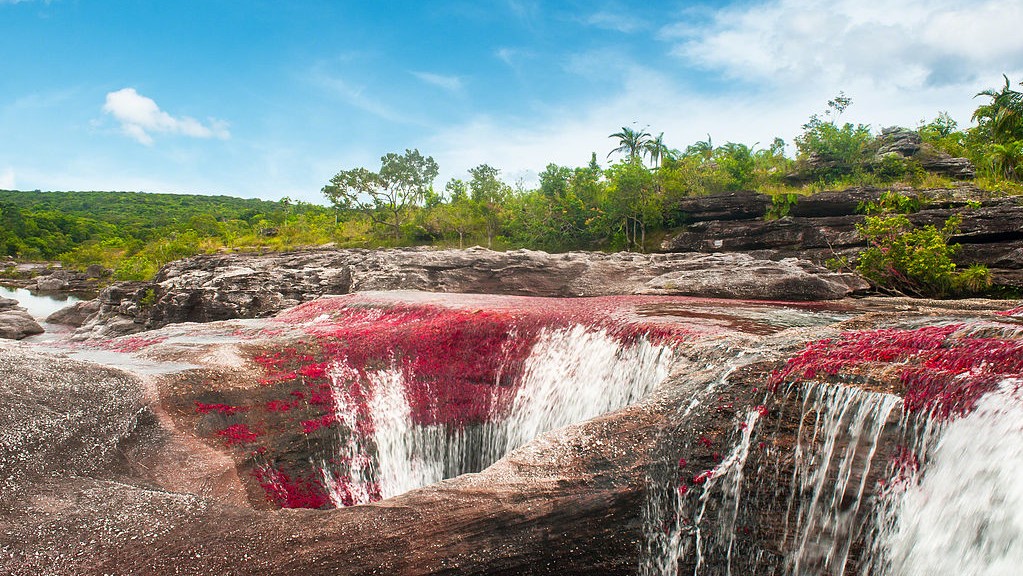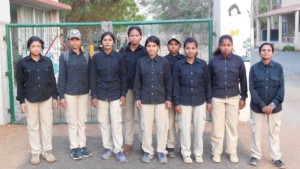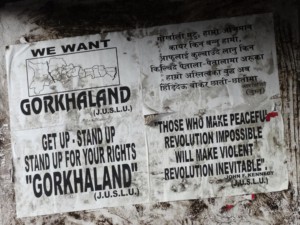Former FARC rebels turn ecotourism guides, but peace remains fragile

About 30 of the estimated 12,000 FARC members demobilised under a peace accord with Colombia’s government have chosen ecotourism as a path to reintegration. The travel & tourism industry would do well to support them. Full story by Anastasia Moloney writing for the Thomson Reuters Foundation.
As a former rebel fighter, Ximena Cruz used to hide and survive in Colombia’s dense forests, but now in peacetime she hopes tourists will visit the once war-torn hilly hinterland in the country’s central Meta province.
Cruz and about 30 former guerrillas from the Revolutionary Armed Forces of Colombia (FARC), who laid down their weapons under a 2016 peace deal with the government, have chosen to become tourist guides as they reintegrate into civilian life.
The 52-year war killed about 200,000 Colombians and forced more than seven million people from their homes.
“We’re committed to peace,” said Cruz, descending the steps built by ex-fighters through a virgin forest of tropical flowers and birds that leads to a gushing waterfall.
“We hope the local community, Colombians and foreigners will visit this paradise that was hidden for so long during the war and see its beauty,” said Cruz, one of the ex-combatants.
Cruz is part of a reintegration project focused on ecotourism, and funded by Norway, that features new hiking trails, rappelling and rafting.
About 12,000 FARC members, including 6,000 combatants, demobilized under the accord that ended half a century of war with the government. The FARC is now a far-left political party that uses the same acronym.
Ensuring former rebels can reintegrate into civilian life is crucial for lasting peace in Colombia.
Successful reintegration means ex-fighters are less likely to return to the battlefield and join other criminal groups or FARC dissident factions who refused to demobilize.

Commune life
Under the peace accord, most rank-and-file fighters were given amnesty while former top commanders are expected to be tried at special tribunals for alleged war crimes and human rights violations, including the bombings of civilian targets.
Since the accord was signed more than two years ago, thousands of ex-fighters have been living in 24 temporary demobilization zones, overseen by the United Nations Verification Mission, scattered across remote rural Colombia.
At the Mariana Paez demobilization zone where Cruz and about 300 other ex-fighters live, once-barren land has been turned into a type of commune village built on Marxist ideals.
Using materials provided by the government, rows of makeshift housing, some adorned with paintings and large photos of guerrilla heroes, a football pitch, classrooms, a community hall and small vegetable gardens have been built.
There’s also a UN-funded bakery and an evangelical church alongside a simple bar with a pool table and cockfighting ring.
Despite being an hour’s drive along a dirt road from the nearest town of Mesetas, ex-fighters hope tourists and birdwatchers will visit the area and stay in their camp.
“The people who will visit us are those who don’t have any prejudices against us. Some people are still afraid of us,” said ex-fighter Monica Suarez, who spent three decades with the FARC.

Obstacles
The government has destined about $2 million for reintegration projects to help ex-fighters set up small businesses.
But more than two years on after the accord was signed, few reintegration projects led and funded by the government are up and running, said Pastor Alape, a former top FARC commander and peace negotiator.
“Up until now, the first project within the framework of the peace agreement hasn’t yet been developed here in this region,” said Alape, who sits on the National Reincorporation Council, a government body overseeing the reintegration process.
He called on the government to step up its “political will” to ensure ex-fighters have a path toward reintegration as stated in the accord.
“The construction of peace is not an act, it is a process,” Alape told the Thomson Reuters Foundation.
Of the 22 projects so far approved by the government, only five have received money. They range from fish farming to ranching to fruit growing, Alape said.
He added those projects that are underway are mostly thanks to funding from Norway, a guarantor country of the peace deal, other European nations and the UN.
Many of the small business ventures set up by ex-fighters on their own are “likely to fail” because they lack the technical expertise, support and investment over the long-term, according to a 2018 report by the think tank International Crisis Group.
Ex-rebels say it costs more to transport a product than to produce it.
“The roads are bad so it’s difficult to get our produce to the local market and town. We also need help with marketing,” said 54-year-old Miguel Molina, who is part of a 10-member chicken cooperative that produces eggs.
Support winding down
Ex-combatants receive a government stipend of $225 a month — equivalent to 90 percent of Colombia’s minimum monthly wage. This financial support is scheduled to end in August.
As the deadline looms, ex-fighters say they face increasing uncertainty about their future and where they will live. Many demobilization zones have been set up on land rented by the government.
“Once August comes, we don’t know what will happen, where we’ll go, what income we will have or if the government will buy the land so we can all stay here,” ex-rebel Suarez said.
Andres Stapper, who heads the government’s reincorporation agency (ARN) said while challenges remain, the right-wing government of Ivan Duque, which has been critical of the peace deal, is “committed” to helping ex-fighters reintegrate.
The government is working to create “a roadmap” to identify whether land within reintegration zones can be bought, he said.
“But many of them are inside farming and indigenous reserves … to which we’re looking for a solution because these properties can’t be bought. Agreements need to be reached with these communities,” Stapper said.
Giving up
For some ex-fighters, the lack of jobs and opportunities has prompted them to abandon the demobilization zones for good.
Colombia’s military estimates 1,200 FARC dissidents are active, with some forming new groups involved in drug trafficking and illegal gold mining.
According to ex-FARC commander Alape, not more than about 500 fighters who demobilized as part of the peace accord have left the zones.
Christian Visnes, the Colombia country director with the Norwegian Refugee Council, which runs education and other projects for ex-fighters, says reintegration efforts and funding must be increased to prevent more violence.
“Two years on, a coherent reintegration effort is still lacking,” Visnes said.
“Clearly, this is contributing to the increasing conflict we are seeing in many of Colombia’s war-torn regions .. where the risk of ex-combatants abandoning the process is increasing.”
Ex-fighters also worry about getting killed.
According to the UN, 85 ex-FARC rebels have been murdered in Colombia since the peace accord was signed, mostly by illegal armed groups fighting for control over former FARC strongholds.

Baby boom
Meanwhile, daily life at the demobilization zones continues — a routine of cooking, cleaning and going to class.
For ex-fighter, 31-year-old Leidy Marin, who says she voluntarily joined the FARC when she was just 12, giving up her weapons has meant the chance to become a mother.
During the war, motherhood was not an option, and most rebel fighters who got pregnant either had an abortion or handed over their babies to relatives or friends to look after, female rebels say.
“It’s important for people to come here to see we’ve kept to our side of the bargain. We’ve left behind our weapons,” said Marin, as she rocked her baby daughter in her arms.
The girl is one of 60 babies born in the demobilization zone in the last two years.
“Now we want to get on with our lives. I’d like to study computer science at university. I want my daughter to have something when she grows up,” said Marin.
Source: The Thomson Reuters Foundation, the charitable arm of Thomson Reuters. Reporting by Anastasia Moloney; editing by Jason Fields.
Featured image: Colombia has its ecotourism treasures such as the Caño Cristales waterfall. Image by Mario Carvajal (CC BY 3.0) via Wikimedia.





